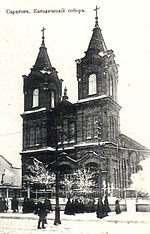Saratov Roman Catholic Cathedral
The Roman Catholic Cathedral of Saratov with the patronage of St. Peter and Paul ( Russian Собор Святых Апостолов Петра и Павла ) is the episcopal church of the Catholic diocese of Saratov in Saratow and the parish church of the local parish . It was consecrated on October 15, 2000 in the presence of the Apostolic Nuncio Georg Zur by Bishop Clemens Pickel .
history
As a result of Catherine the Great's settlement policy, many Catholics from Germany came to the Volga and Black Sea regions in the 18th century . In 1805 the first Catholic church and school was built in Saratov. In 1848 the diocese of Tiraspol was founded with its seat in Saratov. In 1882 the double-towered neo - Romanesque cathedral was completed. It received the patronage of St. Clement , who, according to legend, was martyred in the Black Sea . Clement of Rome is also the patron saint of today's diocese of Saratov.
In the course of Stalinism , the old cathedral was converted into a cinema in 1936, which still exists today. After Germany's attack on the Soviet Union in 1941, many Volga and Black Sea Germans were first deported to Germany and later to Siberia and Kazakhstan , others perished from war and hunger. The huge southern Russian diocese now comprises just over 20,000 Catholics, the Saratov community only a few hundred, including many members of Polish descent.
Around 1990 a new community life began in Saratow and Engels , initially with meetings in apartments. In 1992 a priest came to Saratov permanently; the holy masses initially continued in private rooms, from 1995 in a makeshift chapel opposite the former cathedral. In the same year the land for the new bishop and parish church was bought. In 1999 the Holy See established the Apostolic Administration of Southern Europe from the majority of the old diocese of Tiraspol , which in 2002 became the diocese of St. Clement in Saratov . Its cathedral became the St. Peter and Paul Church, completed in 2000.
architecture
St. Peter and Paul is made of red brick and gray-white exposed concrete . Round, wave-shaped and cubic components are nested within one another. The apse , in which the altar is located, continues beyond the nave roof as a round tower, the sloping roof of which carries a cross at the highest point.
Web links
- Official Website (Russian)
- Timeline to history
- History (russian)
Coordinates: 51 ° 31 ′ 38.4 " N , 46 ° 2 ′ 41.2" E


